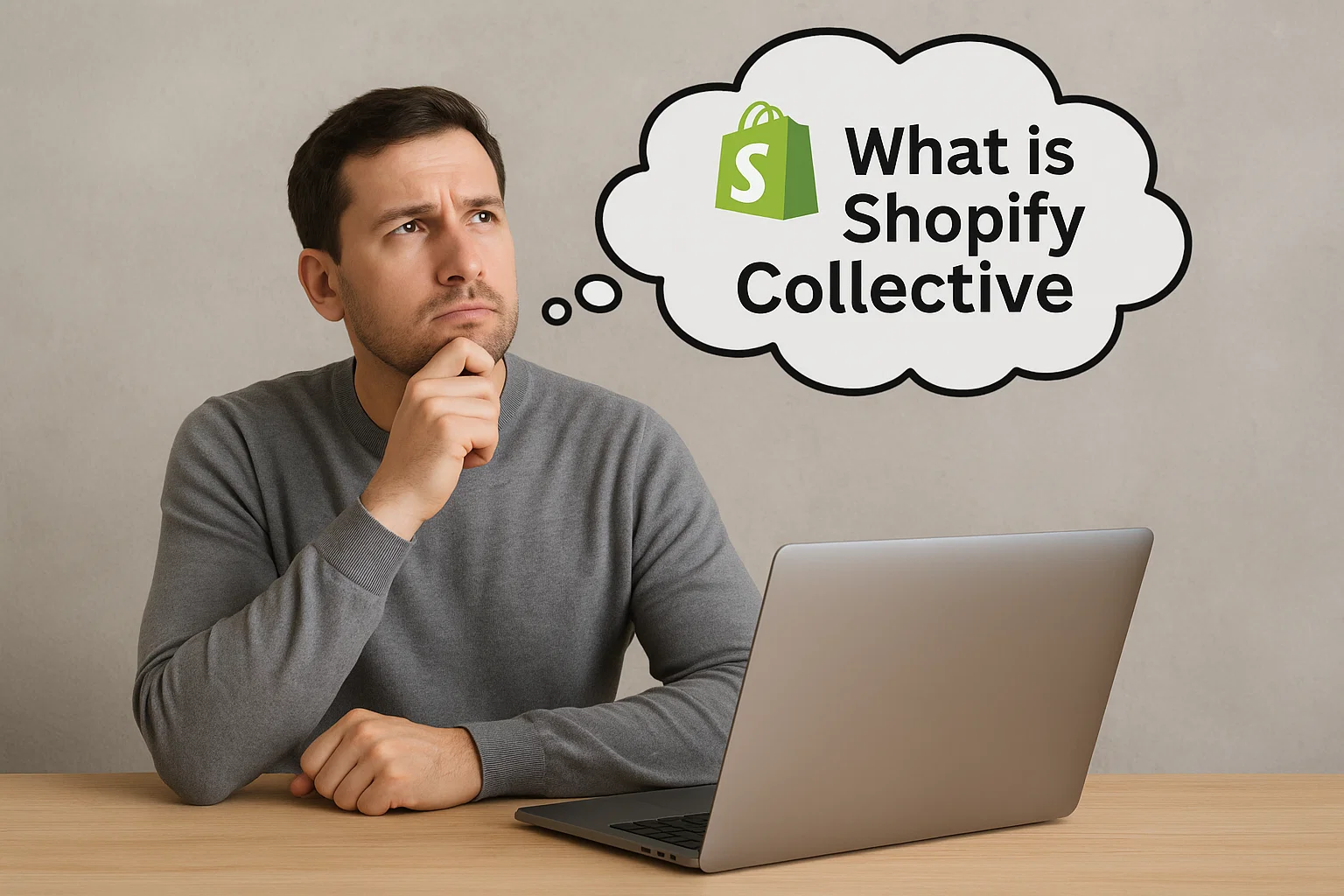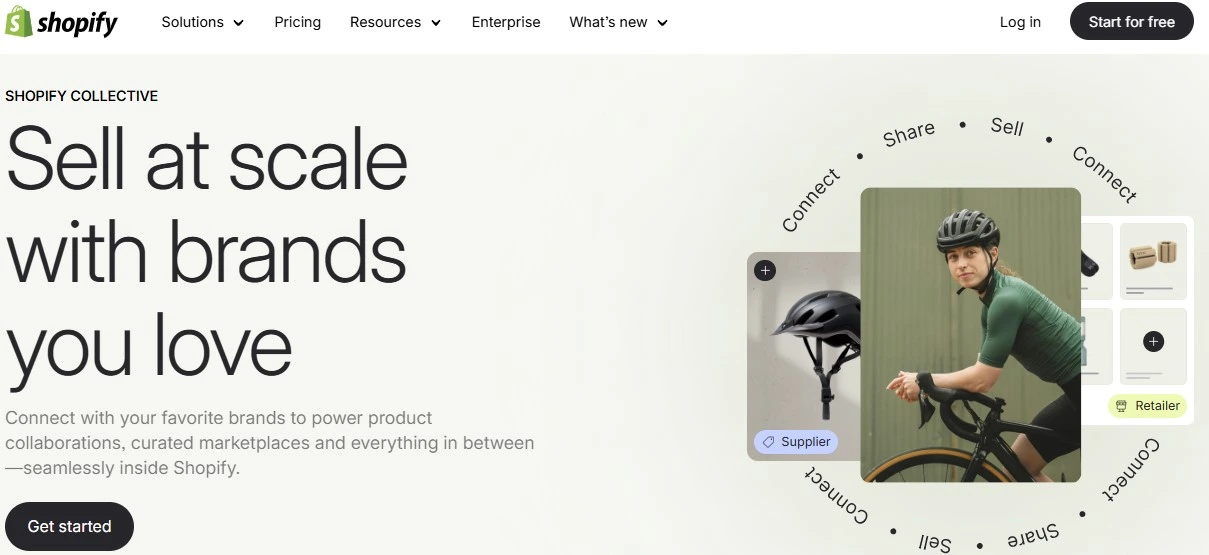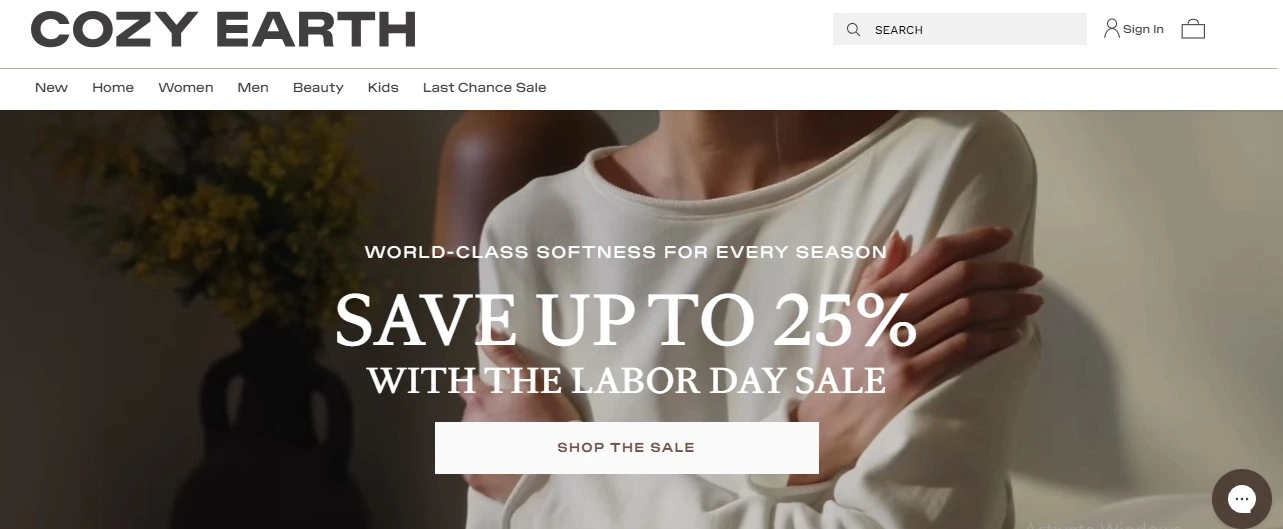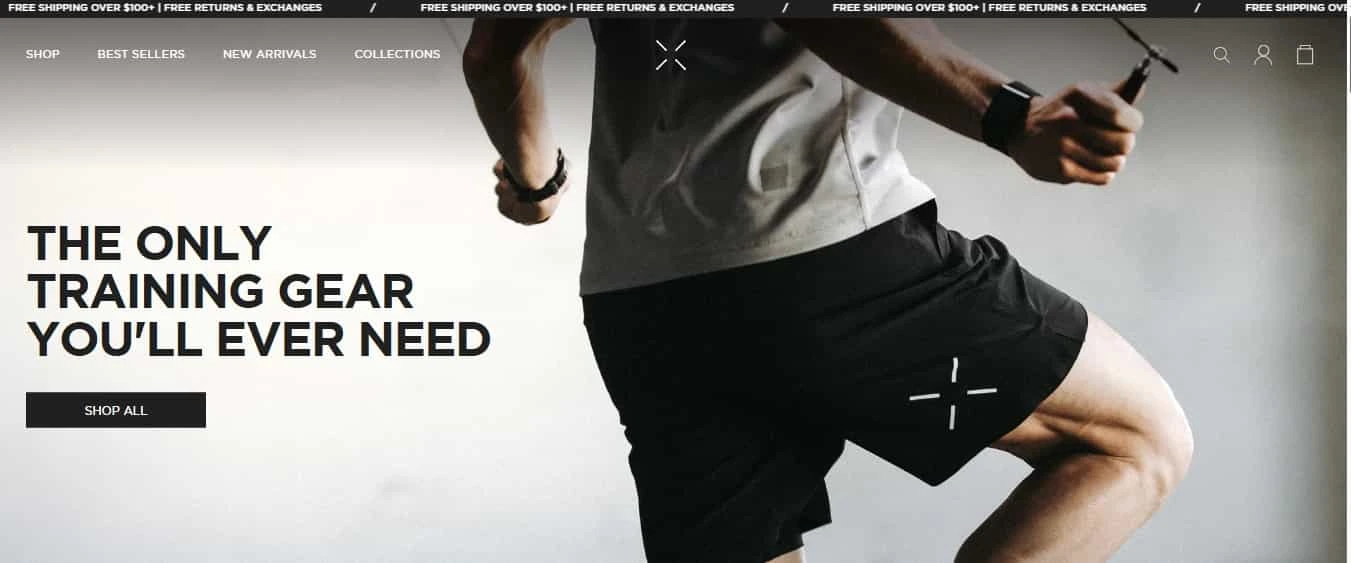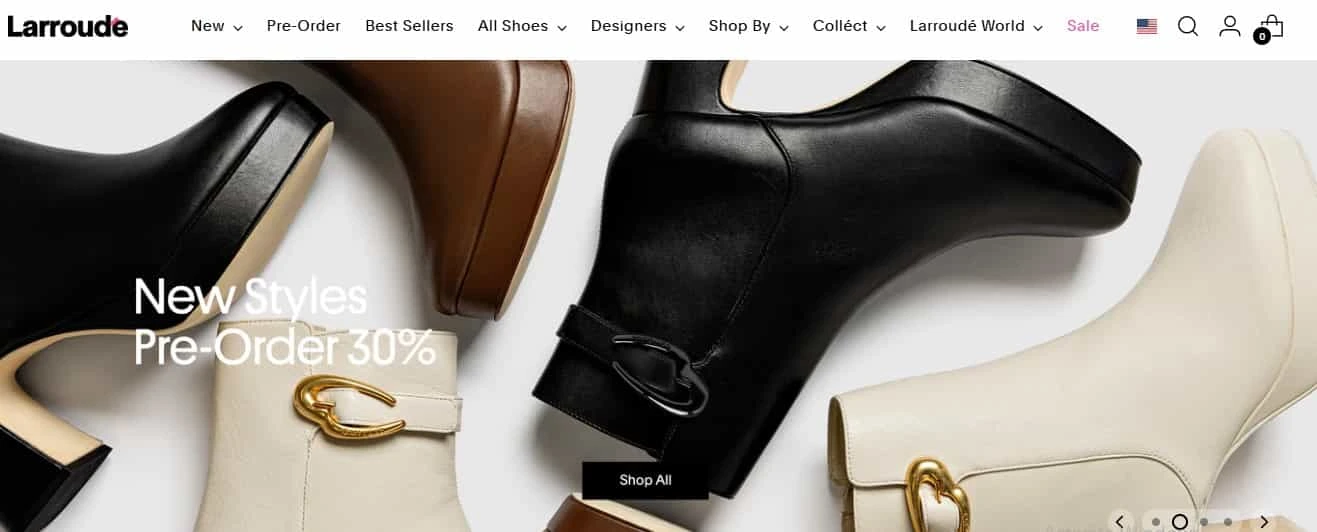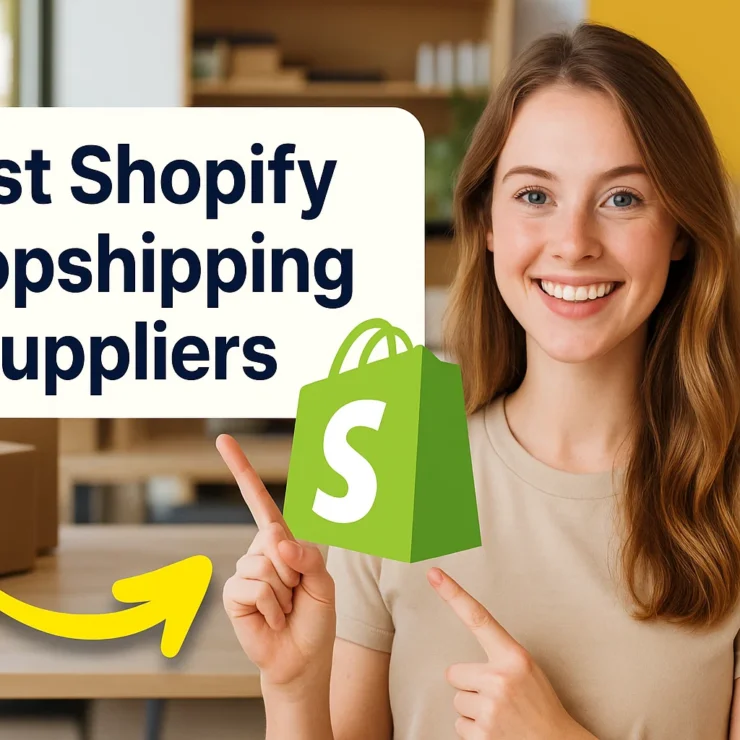Shopify Collective is Shopify’s built-in solution that helps retailers and suppliers work together more efficiently. Retailers can easily add products from suppliers without worrying about inventory, while suppliers get a chance to reach new customers through established Shopify stores.
In short, Shopify Collective is designed to make eCommerce partnerships smoother, reduce risks, and create new opportunities for growth in 2025.
Need help while customizing your theme? Here’s how to contact Shopify support in 2025 if you run into any issues.
What is Shopify Collective?
Shopify Collective is a strategic solution created by Shopify to help retailers and suppliers collaborate within the same ecosystem. At its core, it’s a program that allows Shopify store owners to broaden their product catalog without the traditional challenges of sourcing, stocking, or managing wholesale inventory. Instead of investing heavily upfront in large product orders, retailers can connect directly with established Shopify suppliers and seamlessly feature their products in their own online stores.
For retailers, this means access to a wider range of products that can complement their existing catalog, increase average order value, and improve customer retention. For suppliers, Shopify Collective provides a powerful distribution channel by making their products available to more stores, leading to increased visibility and sales. It’s essentially a win-win partnership model where both sides can grow without unnecessary friction.
Unlike conventional wholesale setups that often require large purchases, logistics coordination, and higher risks, Shopify Collective simplifies the process by integrating everything directly into the Shopify platform. Retailers can showcase products from partners as if they were their own, while suppliers retain control over pricing, branding, and fulfillment.
In short, Shopify Collective is more than just a sales tool—it’s a modern business growth strategy. By enabling trusted partnerships within Shopify’s ecosystem, it empowers both retailers and suppliers to scale faster, diversify their offerings, and provide more value to customers without overextending their resources.
Official eligibility requirements for 2025
To use Shopify Collective, your store must meet the following conditions:
You must comply with Shopify Collective’s Terms of Service, Shopify’s Terms of Service, and the Acceptable Use Policy
Your business must be based in the United States or Canada, and your store currency must be set to USD or CAD
Shopify Payments must be fully activated — third-party payment gateways are not supported
Your store must be on an active, paid Shopify plan (free trials and development stores aren’t eligible)
You must complete Shopify Payments verification, including all required onboarding steps
If any of these criteria aren’t met, you’ll see a banner on your Collective Overview page. Click Check requirements to view the specific issues preventing access.
Ongoing Compliance Checks
Shopify automatically re-evaluates store eligibility on a regular basis. Meeting the criteria once isn’t enough—ongoing compliance is required.
If your store falls out of compliance, your imported products will be paused immediately, and they won’t be available for sale until the issues are resolved.
Start a free trial and enjoy 3 months of Shopify for $1/month
🚀 Start Shopify TrialTrusted by over 2,000,000 businesses worldwide
How Shopify Collective Works
Shopify Collective works by connecting retailers and suppliers directly within the Shopify ecosystem, allowing seamless product integration, automated order processing, and synchronized inventory management. The system ensures both sides can collaborate efficiently while maintaining brand consistency across all sales channels.
Shopify Collective for Retailers
For retailers, Shopify Collective provides a straightforward way to expand product offerings without managing inventory or logistics. The process works in three simple steps:
Connect with Suppliers – Explore and connect with verified suppliers through the Shopify Collective interface.
Import Products – Add supplier products to your store, complete with descriptions, images, and pricing.
Manage Orders – Orders are automatically routed to suppliers for fulfillment, while retailers track performance from their Shopify dashboard.
Once connected, inventory updates and order processing happen in real time. This allows retailers to focus on growth, marketing, and customer relationships rather than backend operations.
Shopify Collective for Suppliers
Suppliers benefit by gaining access to new sales channels and reaching customers through retailer storefronts. Participation is simple:
Upload Product Catalogs – Share accurate product details, images, and pricing.
Set Wholesale Prices – Define wholesale or negotiated rates for retailers.
Configure Shipping – Add shipping rules, rates, and timelines to ensure smooth delivery.
When an order is placed, suppliers are instantly notified and can process shipments through their preferred logistics channels. Automated syncing ensures accurate inventory management and reduces errors.
This connected approach empowers both retailers and suppliers to scale faster, reduce operational friction, and create a win-win ecosystem for sustainable growth.
Learn how to effectively add customer reviews on your Shopify store to enhance trust, increase engagement, and boost overall sales conversions.
Shopify Collective Benefits for Retailers
Retailers using Shopify Collective gain access to a powerful toolset that makes product expansion and business growth easier than ever. By connecting directly with suppliers, retailers can diversify their offerings without worrying about stock management, fulfillment, or supply chain hurdles. Here are the major benefits:
Expand Product Catalog Effortlessly
Retailers can quickly add new products from trusted suppliers to their stores without upfront investment in inventory. This allows them to test new categories, follow seasonal trends, and cater to changing customer demands without financial risk.
No Inventory Management
Since suppliers handle product storage and fulfillment, retailers don’t need to worry about warehouse costs, stockouts, or overstocking. Inventory levels automatically sync between suppliers and the retailer’s store, ensuring customers always see accurate product availability.
Streamlined Order Fulfillment
Orders placed on the retailer’s store are automatically routed to the supplier for processing. This automation saves time, reduces errors, and ensures faster deliveries — all while the retailer continues to provide a seamless shopping experience for customers.
Higher Profit Margins with Low Risk
By working on a wholesale pricing model, retailers can set their own retail prices and maintain healthy margins. Since there are no upfront costs for inventory, the risk of financial loss is significantly reduced.
Focus on Marketing & Customer Experience
With logistics and fulfillment handled by suppliers, retailers can focus entirely on growth strategies — from digital marketing campaigns to building strong customer relationships. This strategic focus often results in stronger brand loyalty and increased sales.
In short, Shopify Collective empowers retailers to scale faster, stay flexible, and deliver more value to customers without increasing operational complexity.
Once your store is fully branded, the next step might be multi-channel selling—here’s how to connect Shopify to Amazon easily.
Shopify Collective Benefits for Suppliers
Shopify Collective is a powerful tool for suppliers looking to expand their market reach, streamline operations, and build lasting partnerships with retailers. Designed to simplify the process of cross-store selling, it connects Shopify stores, allowing suppliers to offer their products to other merchants seamlessly. Here are the key benefits:
Expanded Market Reach
Suppliers can instantly reach new audiences without investing in additional marketing or infrastructure. Through Shopify Collective, their products are listed on multiple retailer storefronts, increasing visibility and potential sales across various niches and customer bases.
Low-Risk Growth
This model supports a dropshipping-style fulfillment process. Retailers handle the customer-facing aspects, while suppliers manage inventory and shipping. It reduces the risk and overhead associated with expanding into new markets or launching B2B partnerships independently.
Automated Operations
Shopify Collective automates essential functions like inventory syncing, order routing, and payment reconciliation. This reduces manual workload, minimizes errors, and ensures a smooth transaction experience for both suppliers and retailers.
Stronger Retailer Relationships
Suppliers can build mutually beneficial partnerships with trusted Shopify retailers. These relationships lead to consistent orders, better brand positioning, and valuable insights into customer behavior across different sales channels.
Increased Brand Exposure
Being featured on multiple stores enhances brand awareness and credibility. Retailers act as brand ambassadors, helping introduce the supplier’s products to their loyal customer base.
Control and Customization
Suppliers can control which products are shared, set pricing, and manage margins, ensuring that their brand integrity and profitability are preserved while scaling.
Find the best third-party logistics providers to help scale your Shopify business through fast, reliable, and cost-effective order fulfillment.
Start a free trial and enjoy 3 months of Shopify for $1/month
🚀 Start Shopify TrialTrusted by over 2,000,000 businesses worldwide
Shopify Collective vs. Traditional Dropshipping
| Feature | Shopify Collective | Traditional Dropshipping |
|---|---|---|
| Platform Integration | Native to Shopify; seamless setup within Shopify admin | Requires third-party tools or manual integration |
| Supplier Network | Curated, verified Shopify suppliers | Broad network (e.g., AliExpress, wholesalers) with variable reliability |
| Product Curation | High-quality, brand-aligned products from known Shopify brands | Unfiltered products; quality and branding can vary widely |
| Order Fulfillment | Fully automated: order routing, shipping, tracking, and payments handled by Shopify | Often manual or semi-automated; higher risk of delays or errors |
| Inventory Syncing | Real-time syncing between supplier and retailer | Requires apps; prone to lag or mismatch |
| Brand Control | Strong: both supplier and retailer maintain control over pricing and presentation | Weak: limited control over product branding, packaging, or pricing |
| Margins & Pricing | Transparent wholesale pricing with controlled retail markups | Retailers set arbitrary margins; often low due to competition |
| Customer Experience | Better shipping times, branded experience possible | Long delivery times, inconsistent packaging and support |
| Returns & Support | Managed within Shopify with clear policies | Depends on individual suppliers; often difficult to coordinate |
| Ease of Use | Easy onboarding and management within Shopify | More complex setup; steeper learning curve |
| Best For | Shopify users seeking reliable partnerships with vetted brands | Beginners looking for quick product sourcing, but willing to accept more risk |
| Risks | Low risk; trusted suppliers within Shopify network | Higher risk due to unvetted suppliers and less integration |
Master proven tactics for driving high-quality traffic to your Shopify store using SEO, social media, paid ads, and influencer marketing.
How to Use Shopify Collective? Step-by-Step
Shopify Collective makes it easy for Shopify store owners to connect, collaborate, and sell each other’s products through direct partnerships. Whether you’re a retailer or a supplier, here’s how to get started and make the most of this tool.
How Shopify Collective Works: The Basics
Shopify Collective connects two Shopify stores—one acting as a retailer, the other as a supplier—to facilitate product sharing, order fulfillment, and revenue growth. The entire process is managed through dedicated apps and built-in integrations within the Shopify platform.
For Retailers: Sell Products from Other Brands
1. Install the Retailer App
Go to your Shopify admin → Apps and Sales Channels → Search for and install Collective: Retailer. Complete the onboarding checklist, which includes setting up fulfillment policies, return handling, and shipping rates.
2. Discover or Invite Suppliers
Use the Discovery tool (available for U.S.-based stores) to browse a curated list of suppliers. Alternatively, invite specific Shopify suppliers manually by sending connection requests. You can view each other’s profiles and accept or decline partnerships—ensuring every collaboration is intentional.
3. Import Products
Once a supplier accepts your request and shares their price list, you can browse their catalog and choose which products to import. Inventory and pricing sync automatically—any supplier updates are reflected in your store in real-time.
4. Start Selling
When a customer places an order, it’s routed directly to the supplier. They handle fulfillment and shipping, while you maintain full control over customer communication and branding.
5. Manage the Post-Purchase Experience
Send order updates, track delivery, and engage customers post-sale using email tools like Klaviyo or Omnisend. You own the customer relationship.
For Suppliers: Share Your Products with Trusted Retailers
1. Install the Supplier App
Head to Sales Channels in your admin and add the Collective: Supplier channel. This unlocks access to Collective’s tools for sharing products and managing partnerships.
2. Build Your Supplier Profile
Complete your business profile, including brand details, shipping origins, return policies, social links, and the types of products you offer. This helps retailers understand your brand and encourages quality connections.
3. Create & Share Price Lists
Group products into customizable price lists for specific retailer segments. Choose your wholesale pricing and control which items are available. Once shared, retailers can import your products directly into their storefronts.
4. Fulfill Orders Automatically
As retailers sell your products, orders will appear in your Shopify admin, just like regular sales. You fulfill the item and ship it to the customer using your preferred shipping method.
5. Get Paid Through Shopify
Payments are processed through Shopify’s payout system. You’ll receive payouts as part of your regular Shopify disbursements—no need to chase invoices or wait on retailers to pay manually.
Stay ahead of the curve with trending, high-demand products to sell on your Shopify store in 2025.
How Much Does Shopify Collective Cost?
Yes—for qualifying Shopify stores, there are no additional fees to access Shopify Collective. There are no onboarding costs, monthly charges, or high commission rates. Standard Shopify transaction fees still apply for any order processed, but beyond that, Collective remains free to use, making it an accessible tool for growing your business without added financial pressure.
What Retailers Need to Know About Costs
Retailers using Shopify Collective can join and start selling without upfront fees or subscriptions, provided they’re located in the United States. This makes it easy to test new products and diversify offerings without investing in inventory. Since products are only paid for after a customer places an order, financial risk is significantly reduced.
The main cost involved is the wholesale price paid to the supplier after a sale is made. Retailers typically see profit margins ranging from 20% to 40%, depending on their pricing strategy and supplier rates. Payments are fully automated—customers pay the retailer at checkout, and Shopify deducts the wholesale amount from the retailer’s balance once the supplier fulfills the order.
What Suppliers Should Expect
For suppliers, Shopify Collective provides a cost-free path to wider exposure and increased sales. There are no platform fees, making it an attractive alternative to paid wholesale networks or marketing-heavy expansion strategies.
Suppliers control their pricing and product visibility, choosing which retailers to work with and what margins to offer. When a retailer sells a product, the supplier is automatically paid via Shopify Payments once fulfillment is complete. This hands-off payment process reduces admin time and ensures consistent cash flow.
By tapping into existing Shopify retailers’ customer bases, suppliers can scale efficiently—boosting visibility, sales, and brand reach without raising marketing spend or taking on added risk.
Want to customize your store’s branding? Learn how to easily remove the “Powered by Shopify” message from your footer.
Brand Examples using Shopify Collective
1. Cozy Earth
Cozy Earth, a premium bedding brand, used Shopify Collective to seamlessly co-brand with their new sister brand, Fount Society. As a result, 46% of Fount Society’s revenue came through Collective, 60% of their web traffic was driven by co-branding, and 36% of sales came from new customers. Shopify Collective enabled automated payments, shared SKUs, and real-time inventory syncing—all without overhauling backend systems. The integration also reduced fulfillment complexity and opened new partnership opportunities via Collective’s discovery feature.
2. Ten Thousand
Ten Thousand, a high-performance men’s activewear brand, used Shopify Collective to launch its first collaboration with rucking brand GORUCK. The result? A 46% increase in average order value, 16% of sales from new customers, and two sellouts within 24 hours—both leading to record-breaking sales days. Collective enabled a fast, seamless setup with real-time inventory syncing, easy co-branded product sharing, and automated payments—all without dev-heavy work. The success validated their strategy and paved the way for more collaborations powered entirely by Shopify Collective.
3. Larroude
Larroude, a luxury footwear and accessories brand, used Shopify Collective to launch “Colléct”—a curated shopping destination featuring products from 17 partner brands. In just one month, they added six new product categories and saw a 21% revenue increase, 5% rise in AOV, and 82% of Collective sales from first-time customers. The seamless integration allowed Larroude to expand their product range without complexity, enabling cross-brand selling and elevating the customer experience—all while spotlighting emerging designers alongside luxury labels.
New to Shopify? Explore how the Shopify website builder helps you launch a professional store with no coding needed.
Conclusion: Shopify Collective
Shopify Collective represents a forward-thinking solution for retailers and suppliers who want to scale without unnecessary complexity. By creating a direct bridge between suppliers and store owners, the platform simplifies product sourcing, expands catalog options, and streamlines fulfillment—all without added costs.
For retailers, Shopify Collective unlocks a new level of flexibility, offering access to high-quality products without holding inventory. For suppliers, it’s a powerful way to extend reach, boost sales, and build brand visibility across trusted Shopify storefronts.
As Shopify continues to innovate, Collective stands out as one of the most practical tools for growth-minded businesses in 2025. Whether you’re a retailer aiming to diversify your product line or a supplier looking to expand distribution, Shopify Collective offers a seamless, scalable, and cost-effective path forward.
FAQ: Shopify Collective
What is Shopify Collective?
Shopify Collective is a platform that connects Shopify retailers with verified suppliers, allowing retailers to sell products without managing inventory while suppliers gain access to new distribution channels.
Who Can Use Shopify Collective?
Shopify Collective is ready to use immediately for stores that meet specific eligibility criteria. If your store qualifies, you can start connecting with retailers or suppliers right away—no complex setup required. Here’s what you’ll need:
Learn more here.
To access Shopify Collective, your store must:
Be on an active Shopify subscription plan
Be located in a supported country
Use a supported currency
Have Shopify Payments enabled
Ensure that your payout currency matches your store’s currency
Agree to and comply with Shopify Collective’s Terms of Service
To be a supplier, your store must be active on the Shop app and meet Shop Merchant Guidelines.
What does it cost?
There are no extra fees for using Shopify Collective itself. Retailers and suppliers only pay their standard Shopify subscription costs, plus any normal operational expenses like shipping or marketing.
Can you use Shopify Collective outside the US?
Currently, Shopify Collective is primarily available for businesses based in the United States. International availability may expand as Shopify continues to roll out updates.
Need Help? Let’s Build Your Shopify Store the Smart Way With – Stores Automation
Why build alone when you can have a team do it for you? At Stores Automation, we create fully automated, done-for-you Shopify stores that are designed to grow while you focus on profits. No tech stress, no guesswork—just a streamlined system that works for you 24/7.
From store setup to product integration, branding, and automation—we handle everything so you don’t have to.
Call us: 302-204-8244
Email us: info@storesautomation.com
Sign up here and let us take it from there.
Let’s build you a store that runs on autopilot—because your time is better spent earning.
